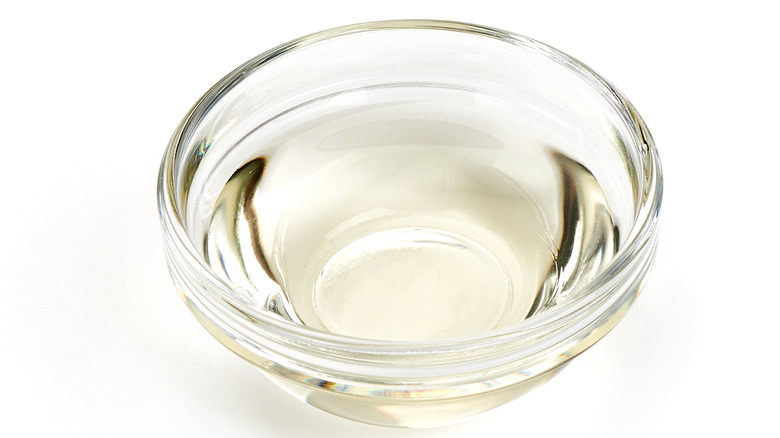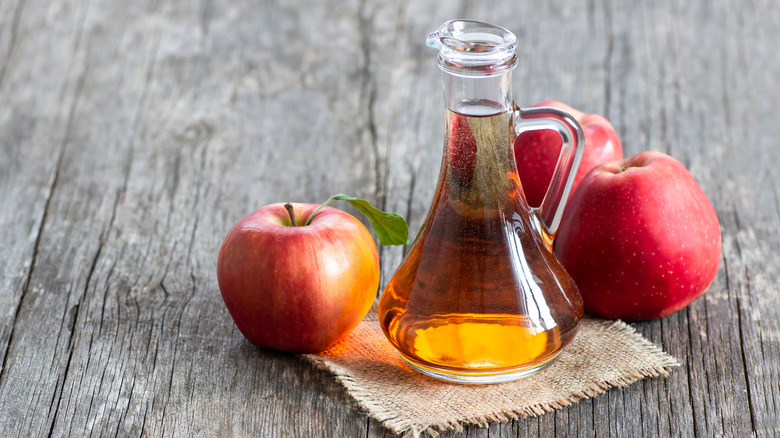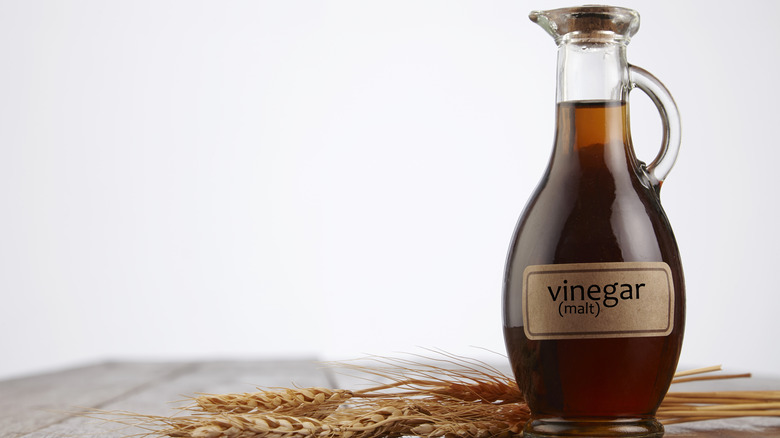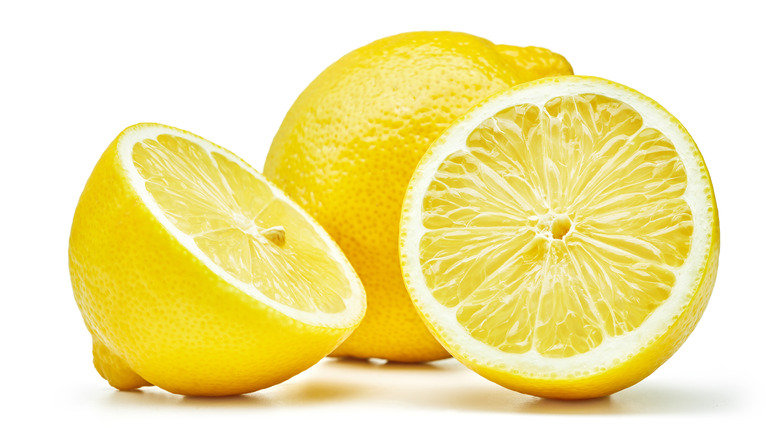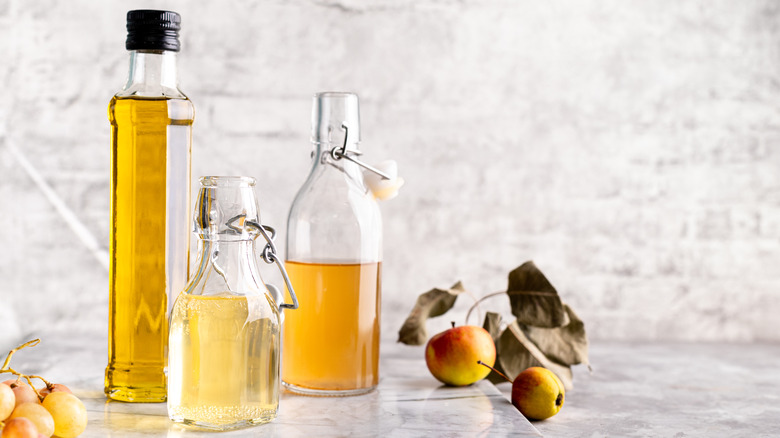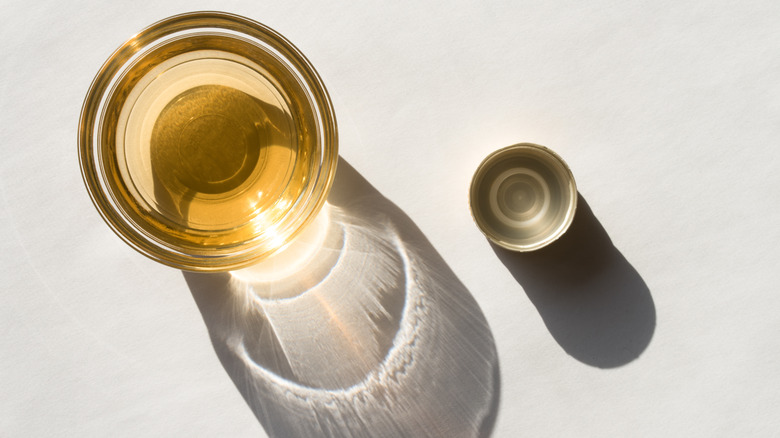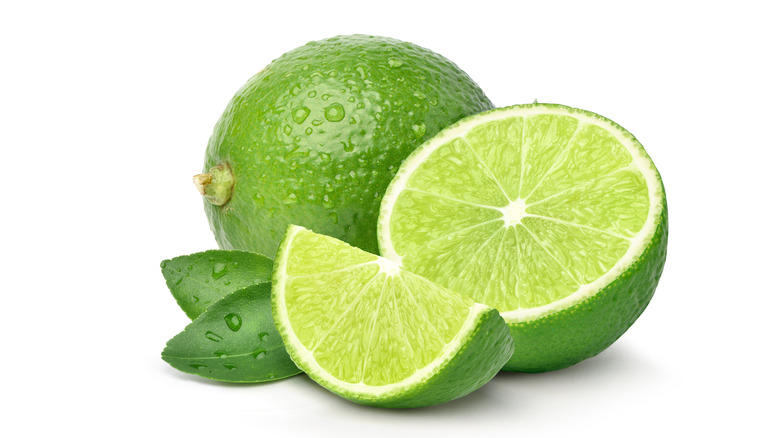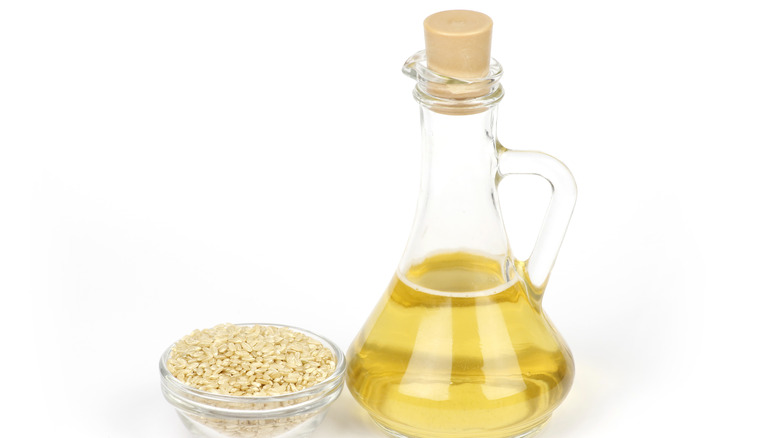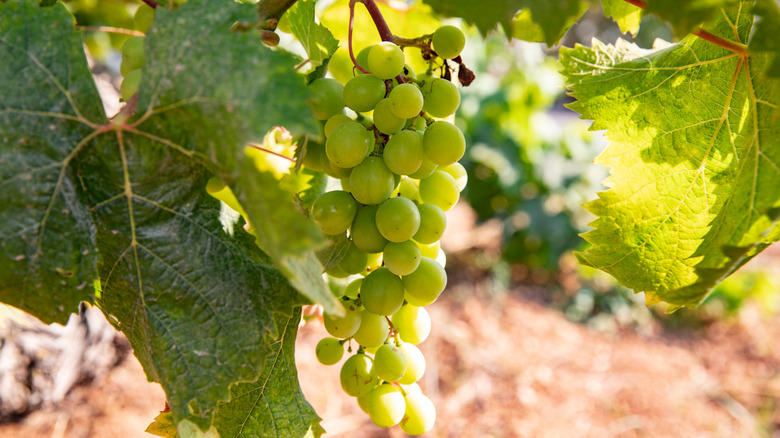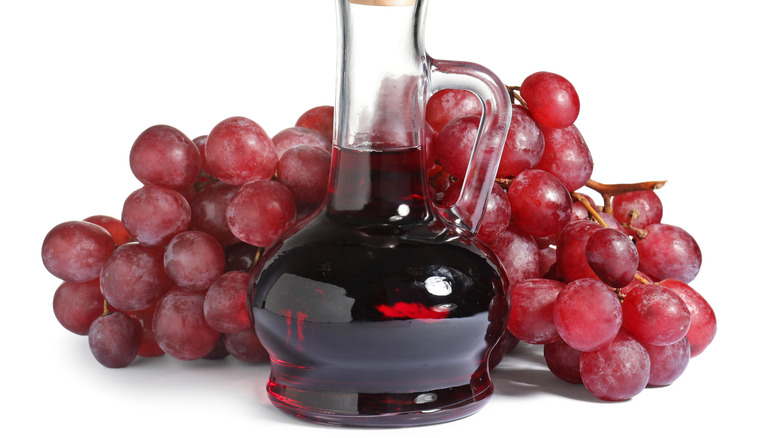10 Best Substitutes For White Vinegar
White vinegar is a cooking and household staple that the vast majority of people likely have in their pantry, for one reason or another. It's a versatile ingredient that adds a serious hit of acidity to whatever you incorporate it in, from zesty salad dressings to marinades that help season mouth-watering proteins. And, it's also an absolute superstar when it comes to cleaning, helping you scrub away even the peskiest stains in your home.
However, as with any ingredient in your kitchen, you may run into a situation where you're whipping up a recipe that calls for white vinegar, only to discover that your bottle has run dry. Sure, you could make an extra trip to the grocery store to get a fresh bottle of the ingredient, but depending on where you're at in the cooking process, that may not be an option.
Luckily, there are quite a few easy options that can stand in for white vinegar in recipes by acting as solid substitutes. If you have a well-stocked kitchen and enjoy cooking, there's a very good chance you'll have at least one, if not more, of these 10 great swaps on hand should you ever run out of white vinegar and require something quick to stand in.
1. Apple cider vinegar
You may have heard people discussing apple cider vinegar in terms of all the health benefits it can offer, and it may indeed be helpful for everything from your skin to your gut, as Healthline reports. However, it's also a fantastic addition to any pantry — and a great substitute for white vinegar in many recipes.
Apple cider vinegar is crafted from fermenting apple cider, as the name suggests, and it has a unique flavor that pairs bold acidity with a hint of fruitiness. Those fruity flavor notes mean it's not an exact match for white vinegar, but it can still work really well in a dish, particularly for recipes that would be complemented by a bit of fruit flavor. One thing to note, however, is the color — while white vinegar is colorless, apple cider vinegar does have a slightly amber hue, which could potentially impact the final look of a dish.
For the best results, you can do a direct swap, using a quarter-cup of apple cider vinegar in place of a quarter-cup of white vinegar, for example.
2. Malt vinegar
Given its dark hue, you may assume that malt vinegar has a completely different flavor profile than white vinegar, but it actually makes an ideal substitute, according to Better Homes & Gardens. Malt vinegar has a delectable combination of tang and sweetness that allows it to work within a variety of dishes, although it's particularly well-suited to fish and chips, as well as other fried or potato-based dishes like french fries, according to Bon Appétit.
One major thing to consider is the hue — given that vinegar in general is typically used in relatively small amounts, it may not be an issue, but using malt vinegar could potentially change the color of a very pale sauce. It also has a slightly different flavor profile, although not in a bad way — it's a bit more complex than white vinegar, with a hint of sweetness and some toasty, nutty flavor notes adding to the dish.
For best results, you'll want to be a tad heavy-handed with this one. The acidity isn't quite as strong as in white vinegar, so you can add a splash more — for example, if the dish you're making calls for a tablespoon of white vinegar, add a tablespoon and a half of malt vinegar and then adjust according to taste.
3. Lemon juice
Lemon juice can be a great substitute for white vinegar because, like white vinegar, it adds a hint of brightness as well as a bit of acidity to whatever dish it's used in (via Leaf TV). It's also a great swap because of just how easily accessible it is — you can find lemons just about anywhere, and if you cook with any regularity, you likely have a few in your fridge or fruit bowl right now. After all, sometimes all a dish needs to take it from okay to incredible is a burst of citrus acidity.
Lemon juice is a particularly good swap for white vinegar in recipes that involve baking, which can be a challenge for certain other substitutes with different pH levels. However, depending on the amount you use, you may want to be aware of the overall flavor profiles — while both white vinegar and lemon juice offer acidity, lemon does have some citrus flavor notes that may change the overall taste of your dish.
For the best results, you can do a direct swap with this substitute, using a tablespoon of lemon juice in place of a tablespoon of white vinegar, for example.
4. White balsamic vinegar
When you think of balsamic vinegar, chances are you think of the variety that's a rich brown hue with equal parts acidity and sweetness — you know, the vinegar that often gets reduced until it's a thick, almost syrupy consistency. It's a very distinct type, and doesn't really work as a great substitute for white vinegar due to the unique flavor notes it features. However, a closely related option, white balsamic vinegar, actually serves as a great swap, according to Substitute Cooking.
White balsamic vinegar is a bit more complex in flavor than regular white vinegar, but it doesn't pack the same powerful flavors that balsamic vinegar does. It does add a hint of sweetness, something you may want to consider when thinking of the overall flavor profile of your final dish. This substitute is best suited for things like salad dressings or sauces, as the color and consistency will remain the same, and the slightly milder flavor actually works well in those types of dishes.
For the best results, you can be a bit generous with this stand-in, since it isn't quite as acidic as white vinegar. So, rather than a direct swap, start with about 1.5x as much and then adjust according to taste. For example, if your dish calls for 1 tablespoon of white vinegar, add in 1.5 tablespoons of white balsamic vinegar and go from there.
5. White wine vinegar
Given how similar their names are, you may have even mistaken white wine vinegar for white vinegar before — and it turns out, you wouldn't have been too far off the mark.
That's to also say that white wine vinegar actually works as a great substitute, as A Couple Cooks reports, since it has a similar appearance and consistency — so your dish won't be impacted in those regards. However, one difference to note is that white wine vinegar does have a bit of a milder taste, with a hint of fruitiness rather than just straight acidity. These more delicate flavor notes mean that white wine vinegar is a particularly great swap when you're making salad dressing, or even just some quick-pickled vegetables as a topping for a dish.
The similarities of these two ingredients means you can easily do a direct swap, for example, using two tablespoons of white wine vinegar in place of two tablespoons of white vinegar in a dressing.
6. Lime juice
A great swap for white vinegar that still packs an acidic punch is lime juice, according to Leaf TV. One of the major perks of this swap is the ease of finding it — if you love to accentuate your dishes with fresh citrus, there's a good chance you may already have a lime on hand, and limes are also readily available at just about any grocery store. Fresh-squeezed lime juice also adds a degree of brightness and freshness to your dish, livening up all the flavors you've already created.
The one thing you'll want to be aware of is the overall flavor profile. This substitute is particularly well-suited to cuisines that frequently feature citrus, such as Thai cuisine. However, if the recipe you're making calls for white vinegar because it needs that zip of neutral acidity and the citrus flavor notes might impact the overall flavors within the dish, you may want to try another swap.
For the best results, you can do a direct substitution, for example using a tablespoon of lime juice in place of a tablespoon of white vinegar.
7. Rice vinegar
If you love to cook Asian cuisine, there's a good chance you might have a bottle of rice vinegar in your pantry — it's not quite as easy to find in all grocery stores as something like white vinegar is, but it's still relatively accessible. It has a similar color and consistency as white vinegar, and works as a great substitute, according to The Kitchen Community.
There's just one major thing to note with this substitution — the sweetness. You'll want to take a quick peek to see if the bottle of rice vinegar you're working with is a regular or a seasoned variety, as The Kitchn explains. Seasoned varieties have added sugar, which will bring a bit of sweetness to your dish that you may not have been anticipating. However, you can still use it as a substitute — you may just want to pay attention to any other elements in the dish, and potentially combat that extra hint of sugar by adjusting some other components.
As Substitute Cooking states, rice vinegar is less acidic than regular vinegar. Consequently, you can be a bit more heavy-handed here: Start with doing a direct swap of one tablespoon of rice vinegar for one tablespoon of white vinegar, for example, and then perhaps add in an extra dash or two if you feel your dish needs a bit more acidity.
8. Champagne vinegar
As you may have assumed based on the name, Champagne vinegar shares a lot of similarities with white wine vinegar, as it's crafted from the same type of grapes that create wines such as Chardonnay, according to MasterClass. It has slight floral notes and a much more mellow acidity. The subtleties in its flavor means that Champagne vinegar is particularly well-suited in recipes that aren't cooked, such as salad dressings or condiments, whereas a vinegar with a more harsh acidity might overpower those items (via Food & Wine).
The one downside with this swap is its availability — while it's not something exclusive to specialty markets, Champagne vinegar is certainly a lot tougher to find in your average grocery store than something like white vinegar or even apple cider vinegar. However, if you happen to have a bottle on hand, it makes a great substitute. And, for those who value a dish's appearance, the golden hue of this vinegar means it won't change the overall look of your dish.
Despite the more subtle flavor and acidity, The Kitchen Community still recommends a 1:1 substitution, calling for one tablespoon of Champagne vinegar to replace one tablespoon of white vinegar. Just be aware that the acidity won't be quite as powerful in your final dish — to adjust, you can always add a dash or two more.
9. Red wine vinegar
If you love making your own vinaigrettes for salads, you likely have a bottle of red wine vinegar in your pantry or kitchen — it's an absolute superstar when it comes to delivering a hint of tangy acidity balanced with some fruity flavor notes that complement a wide variety of greens. Its palate-pleasing flavor means it also makes a good substitute for white vinegar, according to Kookist.
The two things to be aware of are color and overall flavor profile. As you may guess by looking at the ingredient, red wine vinegar does have a rosy hue — not as dark as an actual glass of red wine, but certainly not as pale as white vinegar. This means that your dish might get a bit discolored if you're working with a lot of pale ingredients. Additionally, red wine vinegar has a more complex flavor profile, with its own fruity flavor notes, whereas white vinegar really just delivers that punch of acidity. This complexity is great in a lot of recipes, but it is a slight change that you'll want to be aware of when cooking.
For the best results, you can do a direct swap with this substitute, such as using a tablespoon of red wine vinegar to replace a tablespoon of white vinegar in a recipe.
10. White wine
If you're the type of home cook who doesn't have a wide variety of different vinegars in your pantry, but who always has a bottle or two of white wine chilling in the fridge, you're in luck because white vino is incredibly useful in cooking, as the French know. According to Foodi Ideas, it makes a great swap for white vinegar in recipes, too. You'll ideally want a white wine with zippy acidity like a Sauvignon blanc rather than a sweeter Moscato, for example. However, since vinegar is typically used in relatively small quantities due to how pungent it is, you should be able to use just about any white wine in a pinch.
This substitute is best used in things like sauces where the alcohol is cooked off and the wine adds a depth of flavor. It can also be a great way to deglaze your pan to keep all those flavors in your dish (via The Kitchn).
Because of how much less acidic wine is than vinegar, for the best results you'll want to use about double the amount. So, for example, if your recipe calls for a tablespoon of white vinegar, you'll add in two tablespoons of white wine instead.
